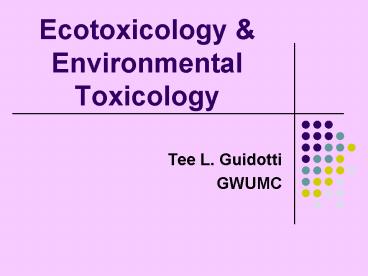Ecotoxicology - PowerPoint PPT Presentation
1 / 32
Title:
Ecotoxicology
Description:
Substances move around and change in the ecosystem. Once released ... Example: A 'typical' water contamination issue. How do we judge the risk ... embryo ... – PowerPoint PPT presentation
Number of Views:173
Avg rating:3.0/5.0
Title: Ecotoxicology
1
Ecotoxicology Environmental Toxicology
- Tee L. Guidotti
- GWUMC
2
Comparison infectious disease, chemical exposure
3
Ecotoxicology
- Fate and disposition
- Release into medium
- Pathways of migration, accumulation
- Biomodification
- Removal, degradation or precipitation
- Ecosystem health
- change in population structure
- health of individual species
- damage to ecosystem
4
Substances move around and change in the ecosystem
- Once released into media partition
- Pathways of movement, exposure
- Metabolism and biomodification
- Exposure of receptors
- Effects on individuals
- Effects on populations
- Recycling and uptake
5
Example A typical water contamination issue
6
How do we judge the risk of this incident?
- Exposure assessment
- pathway
- magnitude
- duration
- Characterize the population exposed
- Risk assessment
- formal/informal risk assessment
- identify subpopulations at risk
7
Concerns in Environmental Toxicology
- Air
- ambient
- indoor
- occupational airborne
- Water
- surface
- ground
- Soil
- contact
- uptake and migration
- Food
- Consumer products
- commercial
- drugs
- cosmetics
- Toxics
- hazardous substances
- waste disposal
- Environmental security
8
Human Toxicology
- Toxicokinetics
- Absorption
- Distribution
- Metabolism
- Excretion
- Toxicodynamics
- mechanisms
- exposure-response
- susceptibility
9
Essentials of Toxicology
10
Absorption
11
Distribution
12
Metabolism and Excretion
13
(No Transcript)
14
Toxicodynamics
15
Toxicology and Ecotoxicology are similar but not
identical.
16
There are also differences.
- Toxicology
- Host defense mechanisms
- Individual susceptibility states
- Single effects
- Cumulative exposure
- Ecotoxicology
- Bioaccumulation
- Bioconcentration (in water)
- Biomagnification
- Never single effects
- Movement between media (air, water)
17
Broad generalizations in toxicology!
- The dose makes the poison
- The most susceptible are the very young, the very
old and the infirm - Interaction and multiple effects may occur
- Occupational and environmental exposures never go
away - they reappear in other settings.
18
Toxic effects are related to age of life.
19
The risk to the next generation.
- First period of risk embryo
- peak period of risk is first trimester, first ten
weeks, during organogenesis - severe damage is likely to result in spontaneous
abortion - Second period of risk fetal development
- some late developing organs
- neurological development and behaviour
- cancer risk
20
The risk to the next generation.
- After birth
- lactation and exposure through breast milk
- environmental exposure
- Toddlers and young children
- accidental exposures
- inquisitive behaviour
- compulsive ingestion
21
Children and Toxic Exposures
- Children are different
- Higher minute ventilation
- More active, behaviourally and metabolically
- Growing
- Incomplete defenses and physiological barriers
22
Physiological Aspects of Exercise
- Increased minute ventilation increases exposure
to airborne hazards - Bypass of host defense mechanisms
- Reduces athletic performance
- Increased metabolic rate
- Airways reactivity
- Increased cardiovascular risk with some exposures
23
How do we manage the risk of this incident?
- Risk characterization - what is the risk?
- Risk assessment - how big is it?
- Risk perception - how do people see the problem?
- Risk communication - talking about risk
- Risk management - doing something about it
24
Exercise and Environmental Health
- Exercise and ecosystem preservation
- wilderness, climbing
- hiking, orientiering, cross-country skiing
- parks and open space
- water sports, sailing
- Extreme environments
- heat stress
- cold stress
25
Exercise and Environmental Health - 2
- Environmental health and risk
- water quality
- water supply
- microbial contamination
- chemical contamination
- bathing facilities
- air quality
- air pollution, health risk and performance
- asthma
26
Exercise and Occupational Health
- Ergonomics
- Occupational health risk
- Fitness to work
- Preplacement screening
- Return to work
- Rehabilitation, impairment
- musculoskeletal
- cardiovascular and endurance
27
Exercise and Air Pollution
- Heavily studied area of environmental physiology
- Increased delivery of oxidant air pollutants
(e.g. ozone) to lower respiratory tract) - Ozone has a direct effect on J-receptors in lung,
inhibits deep inspiration - Older people show less effect
- Tolerance developed, lost quickly
28
Example Air Pollution
- A complex set of issues
- Recognition that PM, ozone associated with
increased mortality - Concern that this reflects cardiovascular risk,
esp. elderly - Exhaustion of susceptibles harvesting
- not proven
- Triggering effect for asthma
29
Air pollution
- The major issues
- reducing
- photochemical
- air toxics
- stratospheric ozone layer depletion,
- enhanced greenhouse effect
- occupational
- indoor air quality
30
Ambient Air Pollution
- Reducing
- Industrial activity
- Mostly sulfur
- High coarse and fine particulate levels
- Characteristic of developing countries
- Bronchitis, most lethal AQ incidents
- Photochemical
- Vehicular traffic
- Mostly oxidants
- Fine particulates
- Developing and developed countries
- Population health effects
31
Health Issues Associated with Modern Ambient Air
Pollution
- Mortality, associated with PM, ozone
- Morbidity
- aggravating lung disease, cardiovascular disease
- eye irritation
- increased risk of URI
- increased frequency of asthma attacks
- Not cancer!
32
Secondary Issues in Air Pollution Management
- Secondary ambient air quality standards may be
set for - plant life
- materials
- visibility
- Loss of amenity is a major issue
- loss of natural beauty
- loss of enjoyment































